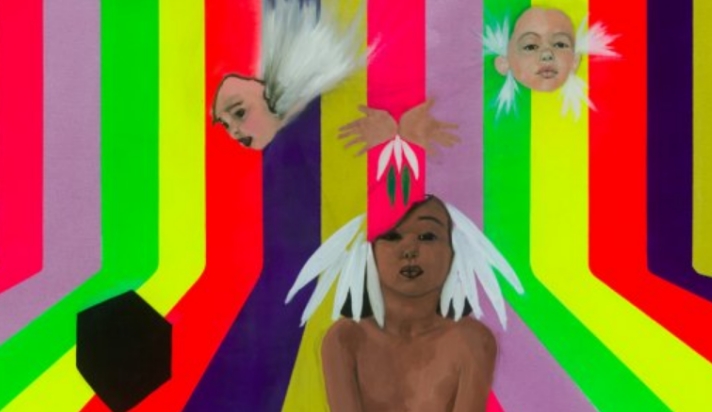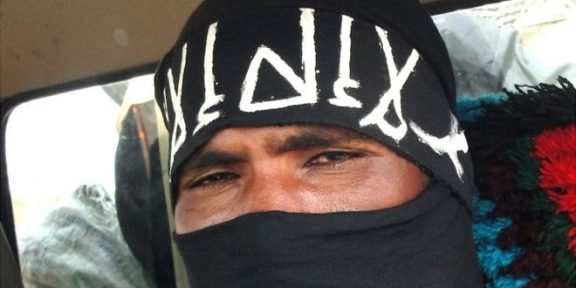At the beginning of 2021, unfortunately a year not very conducive to exhibitions, the Franco-Algerian artist Dalila Dalléas Bouzar is nevertheless present almost everywhere in France, offering several opportunities to discover work that is simultaneously sensual, demanding and committed.
Her paintings are exhibited in Bordeaux at the Frac Nouvelle Aquitaine (Memoria: Tales from Another History) and at the Association Föhn, which will soon be offering guided visits to the artist’s Bordeaux studio.
Among her most notable works include her vast Adama tapestry, which was created in 2019 and presented as part of the Love, etc. exhibition at the Bargoin museum in Clermont-Ferrand, as well as a series of recent paintings which are housed at the Cécile Fakhoury Gallery in Paris.
Bouzar was born in 1974 in Oran and now works in Bordeaux. Her favourite medium is painting, which she uses both on and off the canvas in performances in which both her own body and that of her models become receptacles of colour.
Weapon of deconstruction
At a time when realist painting is discreetly returning to the forefront after facing years of contempt, Bouzar has decided to use it as a weapon for deconstructing the dominant discourse.
In the Innocent catalogue, which accompanies her second solo show and was written by the Cécile Fakhoury Gallery, the artist said to researcher Elsa Guily that “using oil paint, the same medium as orientalist painters, but also the technique par excellence of classicism, is a strategic choice that allows me to return to the source of this historical construction of the Western discourse on art. Delacroix’s Women of Algiers, like Marc Garanger’s photographic campaign during the Algerian War, which serves as the inspiration for my series Princesses, both raise the question of the double submission to the coloniser and to patriarchy.”
The Princesses series, which highlights the dignity of Algerian women, is part of the exhibition Memoria: Tales from Another History. However, it would be wrong to argue that the artist only deals with the colonial past. To create her Adama tapestry – which represents, among other things, the three ages of women – Bouzar worked with Algerian embroiderers who specialise in making karakou, a traditional jacket worn by brides.
“I wanted to divert this know-how from its traditional function to produce another discourse on women, their bodies and their social condition, to make it a new tool of power, in the service of liberation,” she says. In fact, during the Hirak uprising, some Algerian women protesters wore the karakou to express their opposition to the patriarchy.
Even though Adama is not currently accessible to visitors, it is still possible to see – on request – some of the works that made up the Innocent exhibition, held in Abidjan, at the Cécile Fakhoury Gallery.
Free and moving women
Several paintings from the Witches series are presented here, in the very “white cube” setting of a bright flat in the centre of Paris. The title refers to the Inquisition, a time when men were so afraid of powerful women that they burned them alive.
“They are normal women that I wanted to put back into the totality of their existence, beyond this period of 15 to 45 years, when they will be available for reproduction. The dynamic, colourful and timeless backgrounds on which they appear were inspired to me by a Japanese cartoon that my daughter watches. As the characters transform into superheroes, they run around a setting made up of coloured lines.” As if transcended by their power, freed from the patriarchal gaze, Bouzar’s women are free and exalted.
Although the political reading of the work in progress is obvious, it would be a pity to confine oneself to it, as the paintings are so seductive in their material and manner. An outstanding colourist and draughtswoman, she manages to capture the palpitation of existence, life even beyond that skin so often erected as a barrier.
A painter of naked flesh, Bouzar plays with skin tones, between dark brown, bright pink, waxy white, pale green, daring even to intertwine them all in the same painting. A mastery of nuances that expresses not only the differences in skin tone within the human species, but also the variations in tones within the same individual according to whether he/she is young, old, tired, sick, filled with emotion, etc. A mastery that goes hand in hand with a precision of line that can be sometimes supported, sometimes suggested, sometimes duplicated and sometimes unfinished.
Even as they assert themselves as paintings, the artist’s works seem to liberate their subjects from the very grip of the linen canvas. Bouzar’s “witches” are indeed alive, and this is perhaps one of the most interesting aspects of these works.
In her practice, and in her performances in particular, the artist paints on the bodies of her living models – often in bright colours – before recreating them on her canvases. As between skin and flesh, as between skin and the world, she creates an exchange similar to a breath uniting the model, her image and the person looking at her. It is an exchange imbued with respect where the painter has abandoned any overhanging position to give the subject complete freedom.
Source: The Africa Report









